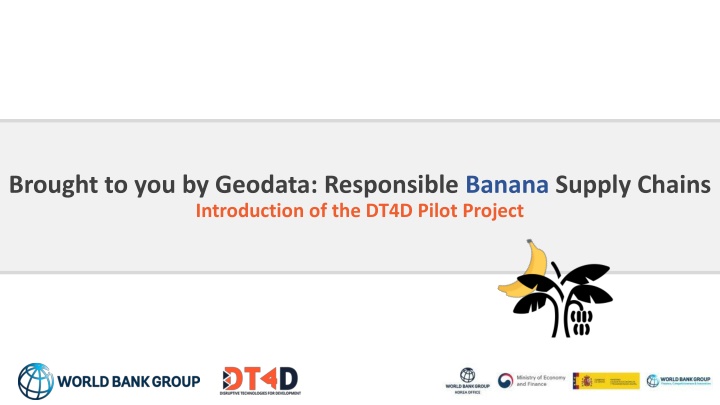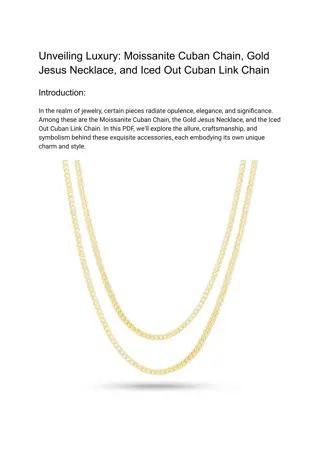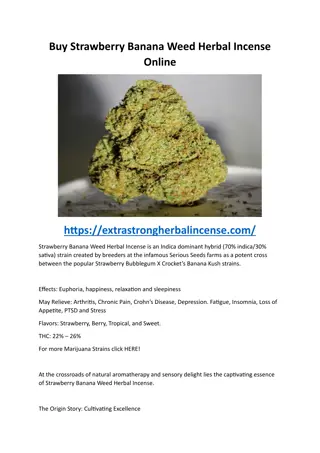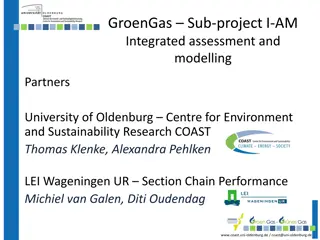Promoting Responsible Banana Supply Chains in the Philippines
The Philippines, as the 2nd largest exporter of bananas, faces sustainability risks such as deforestation, climate change, and labor issues. The introduction of the DT4D Pilot Project aims to address these challenges by providing stakeholders with a digital platform to visualize and manage environmental and social risks in banana production. By improving transparency and promoting responsible practices, the project seeks to enhance the sustainability and competitiveness of the Philippine banana industry.
Download Presentation

Please find below an Image/Link to download the presentation.
The content on the website is provided AS IS for your information and personal use only. It may not be sold, licensed, or shared on other websites without obtaining consent from the author.If you encounter any issues during the download, it is possible that the publisher has removed the file from their server.
You are allowed to download the files provided on this website for personal or commercial use, subject to the condition that they are used lawfully. All files are the property of their respective owners.
The content on the website is provided AS IS for your information and personal use only. It may not be sold, licensed, or shared on other websites without obtaining consent from the author.
E N D
Presentation Transcript
Brought to you by Geodata: Responsible Banana Supply Chains Introduction of the DT4D Pilot Project
Banana production and sustainability context Banana production and sustainability context The Philippines is the 2nd largest exporter of bananas in the World 2020 2014-2018 2019 4.40 M TONS 3.72 M TONS 2.61 M TONS www.trademark.org; 2018 FAO, 2020 Banana Production By region Prevalent Sustainability Risks and Concerns Environment Deforestation | Land-use conversion | Climate change issues | Soil degradation | Biodiversity loss | Proliferation & use of illegal chemicals | Pest and disease | High Pesticide use | Water resources SocialandLabor Land disputes | Decent wages | Child labor | Forced labor | Operational Health and Safety | Gender discrimination and sexual harassment Source: Philippines Statistics Authority, 2014-2017
The case for Responsible Banana Supply Chains The case for Responsible Banana Supply Chains Philippines Banana Industry Challenges and Opportunities Access to markets and impacts of regulatory compliance E&S Standards are Common Requirements for Agricultural enterprises Access to markets - obtain financing from investors - maintain a strong brand and reputation rising consumer demands for responsibly-sourced products Countries around the world (see EU Member States) are increasingly introducing new E&S legal requirements Unlocking opportunities for local economic development For Smallholder farmers, adherence to E&S standards increase business opportunities, give access to international markets & higher returns Philippine Banana Industry Roadmap (2019 2022) Promote inclusive growth through a value chain approach | Increase quality and sustainability levels | Upscaling strategies for sustainability | Improvement in Productivity Level | Moving up in the value chain | Ensuring Market Awareness | Resource generation and Financing Strategies | R&D
DT4D Grant Overview DT4D Grant Overview Objective: provide government, private sector, farmers and other stakeholders with improved information on actual and potential social and environmental adverse impacts for banana production in Mindanao E&S risk visualization live platform Digitized & location- based risks Problem Identification Lack of common and interactive platform for current and potential E&S Risks Lack of shared understanding between Business, Government, Farmers Prevalent environmental, social and labor risks Paper-based E&S risk assessment POST PROJECT IMPLEMENTATION Integrated and visualized E&S risk assessment platform in pilot areas Enhanced Responsible Agriculture Investment (RAI) Enhanced RAI with an integrated platform that visualizes E&S Risks and voice to farmers Enhanced Social and Environmental Sustainability E&S risks are identified and digitized
Disruptive Technology and List of Potential Indicators Disruptive Technology and List of Potential Indicators Disruptive Technology & Potential E&S indicators ENV indicator % change of land surface used for banana cultivation % change in forested area Volume of pesticides used Volume of fertilizer used Water quality measurement results % change in availability of water for agricultural purposes % change in availability of water for community use Soil testing results Number of workers (including by gender) % of workers who are unionized Number of grievances reported by workers Number of training and refresher sessions held on OHS Number of stakeholder engagement meetings held Number of grievances reported by communities Number of children reportedly working on site Number of security incidents reported Number of OHS incidents, accidents, illnesses reported Number of households physically displaced Number of community members economically displaced Wages paid to workers (minimum, maximum and average, including by gender) Smallholder income (minimum, maximum and average, including by gender) DISRUPTIVE TECH E&S indicators Env. Risk Indicators EO Social and Labor indicator remote sensing/radar data Social Risk indicators App Crowdsourced from GEMS tool with location Base map Pilot area Existing map and/or EO data Indicators extracted based on international standards, including OECD-FAO Guidance for Responsible Agriculture Supply Chains and IFC Performance Standards
Agricultural enterprises and Disruptive Technology Agricultural enterprises and Disruptive Technology Mobile technology is increasingly used by companies to support the monitoring of social risks, in particular labor and working conditions, all the way to the farm level. It is often used to support access to grievance mechanisms Satellite imagery & geospatial information uses mages captured by satellites to monitor environmental risks and impacts related to land use change, deforestation, landscape changes. Often relies on other tools to support the analysis and reporting of what the satellite images are capturing Blockchain commodities upstream decentralized real-time information to be gathered and shared within a network of authorized users supports from production traceability downstream and of to Data visualization methods Dashboards are commonly used by businesses to obtain an overview of both E&S risks in their supply chains and inform responsible sourcing decisions allows
DT4D Pilot Sequencing DT4D Pilot Sequencing Completed DT4D Challenge 2.0 Pilot project for E&S risks mitigation for sustainable banana production Engagement with Government Prevalent risk identification Technology literature review External partner consultation Tech Provider Environmental risks Visualize and Store in appropriate platform (Implementation) 1. Show case 1. 2. 3. Government Businesses Civil Society Identify Pilot area, and E&S indicators Identify, strategize, and mitigate risks 2. Adopt/expand our technical solutions (Advisory) Engagement with: 1. Government 2. Businesses 3. Farmers associations and/or CSOs Social risks 3. Disseminate for replication for other supply chains at scale Tech Provider
Next steps Next steps Businesses Government Counterpart: Department of Agriculture for Responsible Agricultural Supply Chains Strategy for engaging with business stakeholders in the Philippines and abroad (business associations and enterprises) Identification of most pressing challenges for the sustainability of banana production, and priority regions Current uses of disruptive technologies for responsible agricultural supply chains Civil Society External Partnerships Strategy for engaging with civil society organizations and relevant farmers associations European Space Agency Earth Observation Clinic and procurement of satellite imagery for environmental risk monitoring Identifying modalities for the piloting of crowdsourced mobile data Technical consultations with FAO and World Banana Forum























